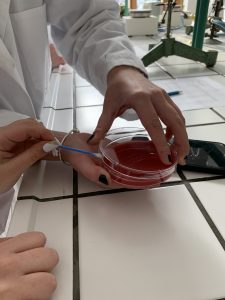Report on biology experiment
INTRODUCTION
This report aims to present one of the experiments that 2nd-year students of Gimnazija Jesenice conduct in biology class. It’s written at request of the ITS English teacher by one of the 2nd-grade students that also participated. The report focuses on the purpose of the experiment, the process, materials used results and gives suggestions and personal opinion.
PURPOSE
The purpose of the laboratory exercise was to isolate and observe the DNA of the tomato to see what it is like, as it is otherwise invisible to the eye. These exercises are practical because they help students remember more than simply listening in class and they learn to handle the equipment used.
MATERIALS USED
The materials used for this exercise were: table salt, water, liquid detergent, ethanol (95%) and tomatoes. A cutting board, scalpel, glass funnel, filter paper, stick blender, a wooden toothpick, glass cup, a test tube, a glass chopstick and a measuring cylinder were also required.
PROCESS
First, 3 g of table salt was weighed and added to a glass beaker with 10 ml of detergent. 100 ml of water was added to the mixture. The tomatoes were cut into chunks and added to the prepared solution. Then the tomato chunks were further “chopped” with a blender, for 2-3 seconds only. The filter paper was placed on a graduated roller and the resulting cell suspension was filtered through it. Then 10 ml of the resulting extract was measured and poured into a test tube. Ethanol (95%) was taken from the cold room, measured and carefully poured down the side of the test tube.
RESULTS
After a while, you could see DNA starting to secrete into the top layer. After a few minutes of waiting, we took a wooden stick and pulled it out of the tube by winding it onto the toothpick. The DNA was later observed both with the naked eye and under a microscope.
COMMENTS
The exercise was well organized and successfully conducted. The students were interested and enjoyed the lesson. Laboratory exercises are very important in science lessons as they give pupils experience in the laboratory and help them predict their solutions, thus helping them to remember more.
